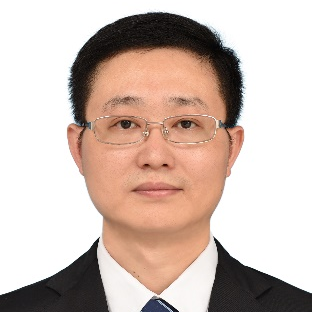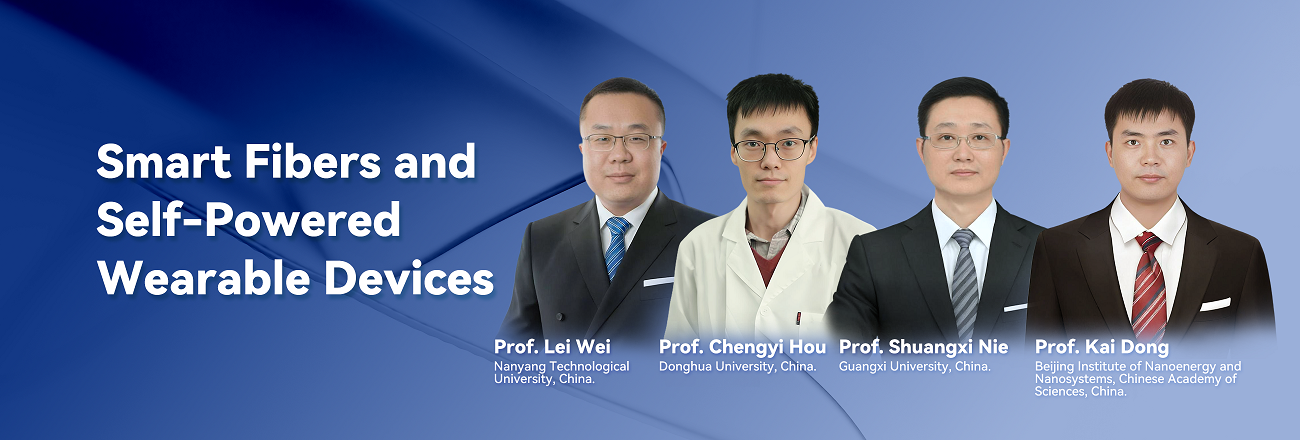Contents
Guest(s)

Prof. Lei Wei
Nanyang Technological University
Lei Wei joined the School of Electrical and Electronic Engineering at Nanyang Technological University (NTU), Singapore, as a Nanyang Assistant Professor in 2014. He was promoted to Associate Professor in 2019 and to Full Professor in 2025, and was awarded the Provost’s Chair Professorship. Since 2018, he has served as the Director of the Photonics Centre of Excellence at NTU, and since 2022, as the Associate Chair (Research) of the School of Electrical and Electronic Engineering. In 2024, he became the Associate Dean of the College of Engineering.
His research focuses on functional fibers, fiber optoelectronic devices, optical fiber sensing, bio-fiber interfaces, in-fiber energy storage, and smart textiles. He has published more than 200 papers in academic journals such as Nature and Science. His major academic service roles include Chair of the Optica Singapore Section and editorial board memberships for several international journals. He was elected an Optica Fellow in 2025.
Lei Wei joined the School of Electrical and Electronic Engineering at Nanyang Technological University (NTU), Singapore, as a Nanyang Assistant Professor in 2014. He was promoted to Associate Professor in 2019 and to Full Professor in 2025, and was awarded the Provost’s Chair Professorship. Since 2018, he has served as the Director of the Photonics Centre of Excellence at NTU, and since 2022, as the Associate Chair (Research) of the School of Electrical and Electronic Engineering. In 2024, he became the Associate Dean of the College of Engineering.
His research focuses on functional fibers, fiber optoelectronic devices, optical fiber sensing, bio-fiber interfaces, in-fiber energy storage, and smart textiles. He has published more than 200 papers in academic journals such as Nature and Science. His major academic service roles include Chair of the Optica Singapore Section and editorial board memberships for several international journals. He was elected an Optica Fellow in 2025.
Topic: Thermally Drawn Functional Fibers
Abstract:
Integrating functional materials with diverse optical, electrical, magnetic, acoustic, thermal, and mechanical properties into fibers can greatly expand the application scope of fiber-based technologies. These multimaterial fibers possess the fundamental characteristics of electronic and optoelectronic devices while remaining compatible with large-scale production. This enables a wide range of fiber-based functionalities, including optoelectronic devices, multifunctional composite materials, bio-information interfaces, energy generation and harvesting, thermal management, health monitoring, and brain–computer interaction.
This talk will provide a systematic introduction to the fundamental concepts of thermally drawn multimaterial fibers, including representative materials and structural designs, as well as their applications across various fields. Key issues and challenges in the development of multimaterial fibers and textiles will also be discussed.
Abstract:
Integrating functional materials with diverse optical, electrical, magnetic, acoustic, thermal, and mechanical properties into fibers can greatly expand the application scope of fiber-based technologies. These multimaterial fibers possess the fundamental characteristics of electronic and optoelectronic devices while remaining compatible with large-scale production. This enables a wide range of fiber-based functionalities, including optoelectronic devices, multifunctional composite materials, bio-information interfaces, energy generation and harvesting, thermal management, health monitoring, and brain–computer interaction.
This talk will provide a systematic introduction to the fundamental concepts of thermally drawn multimaterial fibers, including representative materials and structural designs, as well as their applications across various fields. Key issues and challenges in the development of multimaterial fibers and textiles will also be discussed.

Prof. Chengyi Hou
Donghua University
Chengyi Hou, born in 1987, is a Research Professor and Ph.D. supervisor at Donghua University. He is a recipient of national-level young talent programs, an EU Marie Curie Fellow, a Jiangsu “Double Innovation Talent,” and a Materials Horizons Emerging Investigator. He has been selected for multiple prestigious talent programs, including the China Association for Science and Technology Young Talent Support Program, Shanghai Young Top Talent Program, Shanghai “Morning Star” Program, Shanghai “Sailing Program,” and Shanghai “Dawn Program.” His research focuses on intelligent fiber materials and devices. He has published more than 100 SCI papers in journals such as Science and holds over 20 authorized Chinese invention patents. His work has been featured in Science and Nature, and was showcased in the exhibition “Great Changes—Celebrating the 40th Anniversary of China’s Reform and Opening-Up.” He has led projects funded by the Science and Technology Commission of the Central Military Commission, the Equipment Development Department, and the National Natural Science Foundation of China (General Program). He has also served as a reviewer for journals including Science, Nature Electronics, and Chemical Society Reviews, and as a project reviewer for organizations such as Singapore A*STAR.
Chengyi Hou, born in 1987, is a Research Professor and Ph.D. supervisor at Donghua University. He is a recipient of national-level young talent programs, an EU Marie Curie Fellow, a Jiangsu “Double Innovation Talent,” and a Materials Horizons Emerging Investigator. He has been selected for multiple prestigious talent programs, including the China Association for Science and Technology Young Talent Support Program, Shanghai Young Top Talent Program, Shanghai “Morning Star” Program, Shanghai “Sailing Program,” and Shanghai “Dawn Program.” His research focuses on intelligent fiber materials and devices. He has published more than 100 SCI papers in journals such as Science and holds over 20 authorized Chinese invention patents. His work has been featured in Science and Nature, and was showcased in the exhibition “Great Changes—Celebrating the 40th Anniversary of China’s Reform and Opening-Up.” He has led projects funded by the Science and Technology Commission of the Central Military Commission, the Equipment Development Department, and the National Natural Science Foundation of China (General Program). He has also served as a reviewer for journals including Science, Nature Electronics, and Chemical Society Reviews, and as a project reviewer for organizations such as Singapore A*STAR.
Topic: Flexible Electronic Materials for Electrical Stimulation in Pain Management and Tissue Repair
Abstract:
Flexible and fiber-shaped electronic materials offer new possibilities for advancing next-generation biomedical materials. Using continuous fabrication techniques such as interfacial self-assembly, melt spinning, and electrospinning, we have developed a series of novel fiber-based electronic materials and devices, including the industrial-scale production of multicompartment, multi-interface conductive fibers. Furthermore, through animal studies, we have demonstrated the biomedical potential of these flexible materials and devices in applications such as brain–machine interfaces, tissue repair, environmental factor detection, and physiological signal sensing.
Abstract:
Flexible and fiber-shaped electronic materials offer new possibilities for advancing next-generation biomedical materials. Using continuous fabrication techniques such as interfacial self-assembly, melt spinning, and electrospinning, we have developed a series of novel fiber-based electronic materials and devices, including the industrial-scale production of multicompartment, multi-interface conductive fibers. Furthermore, through animal studies, we have demonstrated the biomedical potential of these flexible materials and devices in applications such as brain–machine interfaces, tissue repair, environmental factor detection, and physiological signal sensing.

Prof. Shuangxi Nie
Guangxi University
Shuangxi Nie is a Professor at Guangxi University, a recipient of the National High-Level Talent Program, and a Guangxi Bagui Scholar. His research focuses on fundamental studies of cellulose, and he pioneered the field of cellulose-based triboelectric materials, using natural cellulose to overcome the limitations of traditional electronic materials and to break through key bottlenecks in bio-based electronic devices.
As corresponding author, he has published over 140 SCI papers in journals such as Nature Communications, Advanced Materials, and Matter. In the past five years, his work has been cited more than 13,000 times, with an H-index of 70. He holds 33 authorized invention patents, five of which have been industrialized. He has received several major awards, including the National Second Prize for Technological Invention, the Fok Ying-Tong Education Foundation Young Teacher Award, and the Guangxi Outstanding Contribution Award for Young Scientists.
Shuangxi Nie is a Professor at Guangxi University, a recipient of the National High-Level Talent Program, and a Guangxi Bagui Scholar. His research focuses on fundamental studies of cellulose, and he pioneered the field of cellulose-based triboelectric materials, using natural cellulose to overcome the limitations of traditional electronic materials and to break through key bottlenecks in bio-based electronic devices.
As corresponding author, he has published over 140 SCI papers in journals such as Nature Communications, Advanced Materials, and Matter. In the past five years, his work has been cited more than 13,000 times, with an H-index of 70. He holds 33 authorized invention patents, five of which have been industrialized. He has received several major awards, including the National Second Prize for Technological Invention, the Fok Ying-Tong Education Foundation Young Teacher Award, and the Guangxi Outstanding Contribution Award for Young Scientists.
Topic: Triboelectric Nanogenerator Based on Cellulose Aerogels
Abstract:
Driven by the global trend toward green and low-carbon development, cellulose aerogels have played an increasingly important role in emerging fields such as distributed energy harvesting and conversion, as well as self-powered sensing. Cellulose possesses a unique multiscale structure, excellent mechanical properties, and abundant reactive sites, enabling the customization of cellulose-based triboelectric aerogels through chemical modification and structural engineering.
By analyzing the microcomponents and microstructures of lignocellulosic fibers, we clarified the key factors governing the multiscale-controlled dissociation, extraction, and chemical functionalization of cellulose. We further expanded the quality-factor theory applicable to regulating the polarization properties of cellulose and constructed biomimetic cellulose triboelectric aerogels.
This series of fundamental studies addressed critical scientific questions regarding the unclear structure–property relationships in cellulose aerogels, ultimately enabling the tailored design and practical application of cellulose triboelectric aerogels.
Abstract:
Driven by the global trend toward green and low-carbon development, cellulose aerogels have played an increasingly important role in emerging fields such as distributed energy harvesting and conversion, as well as self-powered sensing. Cellulose possesses a unique multiscale structure, excellent mechanical properties, and abundant reactive sites, enabling the customization of cellulose-based triboelectric aerogels through chemical modification and structural engineering.
By analyzing the microcomponents and microstructures of lignocellulosic fibers, we clarified the key factors governing the multiscale-controlled dissociation, extraction, and chemical functionalization of cellulose. We further expanded the quality-factor theory applicable to regulating the polarization properties of cellulose and constructed biomimetic cellulose triboelectric aerogels.
This series of fundamental studies addressed critical scientific questions regarding the unclear structure–property relationships in cellulose aerogels, ultimately enabling the tailored design and practical application of cellulose triboelectric aerogels.
Moderator

Prof. Kai Dong
Beijing Institute of Nanoenergy and Nanosystems, Chinese Academy of Sciences
Kai Dong is a Young Researcher and Ph.D. supervisor at the Beijing Institute of Nanoenergy and Nanosystems, Chinese Academy of Sciences (CAS), and the head of the Smart Textiles Laboratory. He received his Ph.D. from Donghua University in 2018, after which he conducted teaching and research there from 2018 to 2019. In June 2019, he joined the Beijing Institute of Nanoenergy and Nanosystems as an Associate Researcher and was promoted to Young Researcher in January 2023.
His research focuses on the optimal design, performance enhancement, scalable fabrication, and integrated applications of novel electromechanical energy conversion fiber materials based on the triboelectric effect. He has achieved a series of innovative results in autonomous power supply and self-powered sensing intelligent fibers and textiles. He has published more than 70 papers in journals such as Nature Communications, Science Advances, Advanced Materials, Advanced Energy Materials, Advanced Functional Materials, and ACS Nano, including over 50 as first or corresponding author. He holds eight Chinese patents, has been cited over 5,000 times, and has an H-index of 35. His work has been featured by numerous media outlets worldwide.
He has delivered more than ten invited talks at domestic and international conferences and has led seven projects, including those funded by the National Natural Science Foundation of China, the Beijing Natural Science Foundation, and the CAS Excellent Young Teacher Program. He has been selected as a Beijing Overseas High-Level Young Talent.
Kai Dong is a Young Researcher and Ph.D. supervisor at the Beijing Institute of Nanoenergy and Nanosystems, Chinese Academy of Sciences (CAS), and the head of the Smart Textiles Laboratory. He received his Ph.D. from Donghua University in 2018, after which he conducted teaching and research there from 2018 to 2019. In June 2019, he joined the Beijing Institute of Nanoenergy and Nanosystems as an Associate Researcher and was promoted to Young Researcher in January 2023.
His research focuses on the optimal design, performance enhancement, scalable fabrication, and integrated applications of novel electromechanical energy conversion fiber materials based on the triboelectric effect. He has achieved a series of innovative results in autonomous power supply and self-powered sensing intelligent fibers and textiles. He has published more than 70 papers in journals such as Nature Communications, Science Advances, Advanced Materials, Advanced Energy Materials, Advanced Functional Materials, and ACS Nano, including over 50 as first or corresponding author. He holds eight Chinese patents, has been cited over 5,000 times, and has an H-index of 35. His work has been featured by numerous media outlets worldwide.
He has delivered more than ten invited talks at domestic and international conferences and has led seven projects, including those funded by the National Natural Science Foundation of China, the Beijing Natural Science Foundation, and the CAS Excellent Young Teacher Program. He has been selected as a Beijing Overseas High-Level Young Talent.












